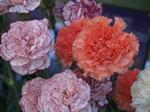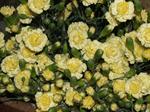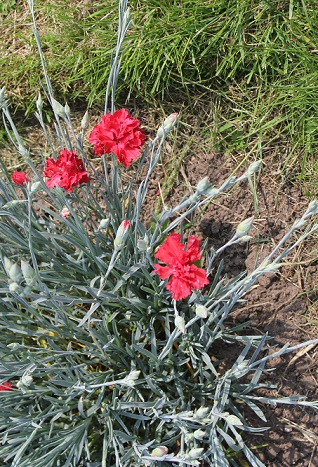
Learn different ways to grow and harvest carnations
- Understand their botany and taxonomy
- Explore cultivars to grow
- Learn about different techniques from in ground to hydroponics, in greenhouses and the open.
This is a course for both amateurs and professionals; flower growers, plant collectors and breeders, flower enthusiasts, nurserymen, landscapers, gardeners and horticulturists.
COURSE STRUCTURE
There are eight lessons, as outlined briefly below.
1. Introduction
- Review of the system of plant identification
- Physiology
- Information sources
2. Culture

- Planting
- staking
- mulching
- watering
- feeding
- pruning, etc.
3. Propagation
- Methods of propagating this group of plants
- Propagation of selected varieties
4. Hydroponics
- Hydroponic growing conditions for carnations
- Nutrient requirements
- Suitable hydroponic systems
- Planting out and cultural techniques
- Carnation problems in hydroponics
- Research insights
- Growing in rock wool
- NFT Culture
5. Pest and Disease
- Fungal Diseases (eg. wilts, rusts, rots)
- Pests (eg. aphids, bud worms, mites, nematodes
- Bacterial Diseases
- Viruses
- Chemical Use
6. Irrigation
- Water deficiency symptoms
- Water excess symptoms
- Understanding water movement in soil
- Managing soil water loss
- Improving water retention
- Hygroscopic water and gravitational water
- Field capacity
- Plant available water
- Permanent wilting point
- Saturation
- Irrigation infiltration and drainage
- Irrigation timing
- Irrigation system types
- Irrigation system maintenance
- Evapotranspiration
- Controlling drainage
7. Greenhouse Management
- Significance of greenhouse carnation production
- Components of a greenhouse facility
- Greenhouse types
- Controlling an enclosed environment
- Environmental factors (light, temperature, growing media/soil, air composition)
- Managing greenhouse problems
- Carbon dioxide enrichment
- Heating
- Ventilation
- Lighting equipment
- Irrigation and nutrition management in a greenhouse
- Managing pest and disease in a greenhouse
- Scheduling carnation crop production
8. Harvest, Post Harvest and Quality
- When and how to harvest flowers
- Factors that affect flower longevity after harvest
- Chemical treatments (eg. germicides, silver thiosulphate, sugar, acid)
- Other treatments
- Quality control (judging and grading flowers, conditioning for market, packaging)
Course Aims
- Differentiate between different carnation cultivars.
- Describe generic requirements for cultivation of carnations.
- Propagate carnations using different methods.
- Cultivate carnations hydroponically.
- Manage pest and disease problems with carnations.
- Manage water requirements of carnations.
- Cultivate a carnation crop in a greenhouse.
- Manage the harvest and post harvest of carnation crops.
Thousands of Varieties.
Carnations belong to the genus "Dianthus". There are over 300 species of Dianthus and many are occasionally given the common name "carnation". Certain species though, and cultivars developed for commercial purposes, from those species; are more commonly called carnations. This course is relevant to all types of Dianthus, but has a particular focus on those species called "carnation", largely because these are the more important horticultural plants.
Sweet William
Dianthus barbatus is one species; commonly called "Sweet William". It is widely grown as an annual bedding plant. It originates in the European mountains (Pyrenees, Carpathian Mountains and Balkans); but has also become naturalised in China and North America.
Sweet William foliage is nearly glabrous (ie. Smooth, without hairs), leaves have a short petiole, leaves are lanceolate with a pronounced mid rib; growing up to 70cm tall (many named cultivars much shorter though), Cymes (flower heads are relatively flat topped, flowers often doubles (ie. double row of petals, with inside row bearded), sweet scent
An annual or perennial (in milder places), D. barbatus can sometimes be short lived, but has spectacular and diverse flowering. Grows best in full sun, likes warm, fertile well drained and slightly alkaline soil. Waterlogged soils will kill these plants
If soil is acidic, add lime before planting. Plant seedlings around 30cm apart. Water regularly and feed at least at the start of spring as growth accelerates. Lime soil around the plants once or twice over summer
Cut back tops of plants with shears lightly; after flowers begin fading.
Propagate Sweet William by sowing seed in a cold frame or greenhouse in autumn; protect over winter and plant out once frosts have stopped in spring. In mild conditions, the same plants can last two or more years; and new plants can be also propagated by division.
Sweet William grows best where summers are cool and winters are mild. A cold wet winter will kill the plants. They are used as bedding plants, borders, cut flowers. (Lower growing cultivars are less suited as cut flowers)
Sweet William Cultivars: A range of cultivars have been developed by crossing Sweet William with D x allwoodii. A popularly cultivated variety is “Sweet Wivelsfield”
Wee Willie is a dwarf sweet William that can start flowering when plants are only 5cm tall. It can produce flowers less than 2 months after sowing seed.

WHAT NEXT?
Register to Study - Go to “It’s Easy to Enrol” box at the top of the page and you can enrol now.
or
Get Advice – Email us at info@acsedu.co.uk OR
Use our FREE COUNSELLING SERVICE to contact a tutor
CLICK TO CONTACT US